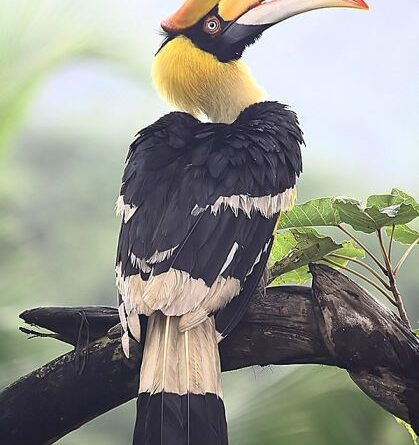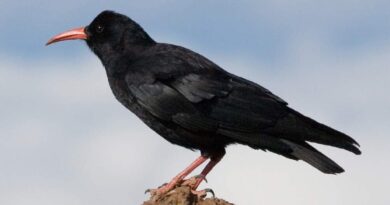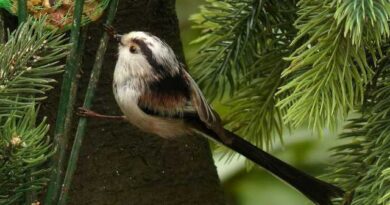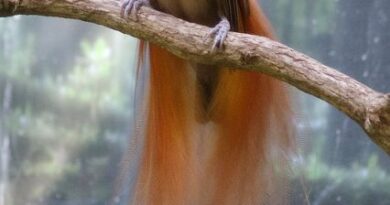Hornbill
Hornbills are an Old-World family of birds with huge, brightly coloured bills. They are classified into two subfamilies: the Bucoracinae, which comprises the two primarily terrestrial African Ground Hornbills (Bucorvus), and the Bucerotinae, which includes over 40 primarily arboreal species. Hornbills are distinguished by their huge bill, which is frequently topped with a high ornate casque. The bill and casque are frequently vividly coloured, and the bill may be ridged and grooved. The casque is in place.
In the males of the Black-casqued hornbill Ceratogymna atrata of West Africa, the Great hornbill Buceros bicornis of India and much of Southeast Asia, and the Rhinoceros hornbill B. rhinoceros of Malaya, Sumatra, Java, and Borneo, it can be large and attain extreme growth. Although the casque is made of a thin exterior coating of horn filled with sponge-like cellular tissue, it has the appearance of being awkward and top-heavy. In Malaya, Sumatra, and Borneo, the Helmeted Hornbill Rhinoplax vigil is an exception. It has a firm casque that is crimson on the outside but golden on the inside and has the substance of ivory. This is known as hornbill ivory, or “hooting” to the Chinese, who used to regard it more than jade or ivory once it has been professionally processed.
On their throats and around their eyes, many hornbills have brilliantly coloured patches of bare skin. Blue, red, and yellow are the most prevalent colours, and they might differ between sexes. In addition, both the Black-casqued hornbill (Ceratogymna elata) and the Yellow-casqued hornbill (Ceratogymna elata) have brilliant, cobalt blue neck wattles. Hornbills have eyelashes that are long, thick, black, and curled, and they are just as appealing as the fake version worn by certain ladies. The majority of species have a prominent, hairy crest. Hornbills’ plumage is typically brightly patterned in black, brown, and white. Although the male’s casque is normally larger and brighter than the female’s, this is not always the case.
From the 15-inch (38-cm) Red-billed dwarf hornbill of West African woodlands to the turkey-sized ground hornbill, Tockus camurus, hornbills come in a variety of sizes. Hornbills of the African savannahs and the Asian forests’ 4-foot (1-3-meter) big hornbills Most have thick tarsi and broad-soled toes, with the three forward-pointing toes partially joined to form a pad. Because of their terrestrial habitat, the two ground hornbills have substantially longer and thicker tarsi. The two bigger species’ flight is arduous and slow, consisting of a succession of wing beats followed by a glide. Flight is light and swooping in the smaller species, with the tail appearing excessively lengthy and ponderous. The larger species are notable for the tremendous rushing noise made by their wings.
Hornbills’ breeding behaviour is even more unique since, with the exception of ground hornbills, all females are walled into the nest chamber during incubation and are fed by the males. The female constructs the wall that blocks the entrance to the nest hole with her own droppings, which are viscid at first but harden when exposed to air. In some species, the male aids the female by providing clay pellets laced with saliva. When the wall is finished, all that’s left is a small opening wide enough for the male to feed the female. When the young are two to three weeks old and about half-grown, the female of the Von der Decken’s hornbill, Tockus deckeni, breaks out of the nest hole and assists the male in feeding them. The young replaster the hole once the female has left. Insects are introduced one or two at a time to feed the two to four young. Females of several other species, such as the Silvery-cheeked hornbill, Bycanistes brevis, on the other hand, stay in the nest until the young fledge. The male of this hornbill must be able to provide enough fruit to feed the female and one or two offspring throughout the duration of their stay in the nest.
When fruit is available, most hornbills consume it, although they will devour practically any animal they can overpower. Poisonous animals make up a large component of the animal food of at least a number of Asian species, including small birds and bats. CLASS: Aves, FAMILY: Bucerotidae, ORDER: Coraciformes, FAMILY: Bucerotidae



